Pirates
To be a Pirate, is to be a robber at sea. There have been thousands of pirates across the world throughout history and in some parts of the world there are still criminals at sea today, who we could call pirates.
However, when we talk about pirates, generally we mean the Pirates from the Golden Age of Piracy over 300 years ago.
Below you'll find some of the most infamous Pirates from history.
Blackbeard
1716-1718
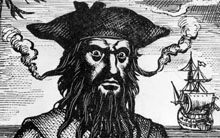
Teach captured a French merchant vessel, renamed her Queen Anne's Revenge, and equipped her with 40 guns. He became a renowned pirate, his cognomen derived from his thick black beard and fearsome appearance; he was reported to have tied lit fuses under his hat to frighten his enemies. He formed an alliance of pirates and blockaded the port of Charleston, South Carolina. After successfully ransoming its inhabitants, he ran Queen Anne's Revenge aground on a sandbar near Beaufort, North Carolina. He parted company with Bonnet, settling in Bath Town, where he accepted a royal pardon. But he was soon back at sea and attracted the attention of Alexander Spotswood, the Governor of Virginia. Spotswood arranged for a party of soldiers and sailors to try to capture the pirate, which they did on 22 November 1718. During a ferocious battle, Teach and several of his crew were killed by a small force of sailors led by Lieutenant Robert Maynard.
Thomas Tew
1692–1695
Thomas Tew, also known as the Rhode Island Pirate, was a 17th century English privateer-turned-pirate. Although he embarked on only two major piratical voyages, and met a bloody death on the latter journey, Tew pioneered the route which became known as the Pirate Round. Many other famous pirates, including Henry Every and William Kidd, would follow in Tew’s path.
Henry Avery ("Long Ben")
1694–1696
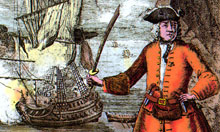
Every was the most notorious pirate of his time; he earned his infamy by becoming one of the few major pirate captains to retire with his loot without being arrested or killed in battle, and also for being the perpetrator of what has been called the most profitable pirate raid in history. Although Every's career as a pirate lasted only two years, his exploits captured the public's imagination, inspired others to take up piracy
Jim Bones
1699 – 1718
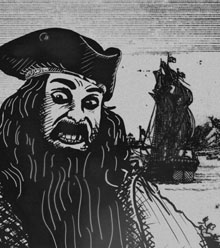
Records indicate that the Pirate 'Jim Bones' probably came from somewhere in southern Ireland. He was active in the atlantic ocean plundering many ships and amassing large amounts of treasure. Although he was ruthless when it came to taking ships, he was renouned for being a fair captain amoungst his crew who called him "The Good Captain". Bones and his crew were known to sail in two ships: His first ship "The Black Swift" is rumoured to have sank somewhere in the caribbean, being lost in a storm after just a year of pirating. His second ship "The Calico Princess" served him well for many years.
Compared to other pirates of his day, Bones was active over an huge period, spanning nearly 20 years. The Calico Princess was finally docked in Penzance, Cornwall in 1718 and neither Bones, his crew, nor (strangely) his ship we're ever seen again. It is assumed that he lived out his days peacefully.
John Quelch
1703–1704
John Quelch was an English pirate who had a lucrative but very brief career of about one year. His chief claim to historical significance is that he was the first person to be tried for piracy outside of England under Admiralty Law and thus without a jury. These Admiralty courts had been instituted to tackle the rise of piracy in colonial ports where civil and criminal courts had proved ineffective.
Black Bart (Bartholomew Rogers)
1719-1722
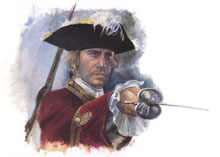
Two years after Roberts was made captain he had accumulated over 51 million pounds worth of treasure and had taken close to 400 ships throughout the Americas, Africa and Europe. His skill had nearly halted Spanish importing and exporting while having lasted this time traveling the Navy Plagued waters, the Caribbean. By this time he had renamed himself Bartholomew Roberts and acquired the nickname "Black Bart."
He decided to return across the Atlantic in order to sell his stolen goods. From there he then proceeded to pillage the African Coast where he took several slaves. This eventually led to a confrontation with the Royal Navy patrol in February of 1722. After catching Robertís consort, the Great Ranger, a British warship, the HMS Swallow, commanded by Captain Chaloner Ogle, caught up to the pirates off the coast of Cape Lopez (present day Gabon). In an attempt to escape, Roberts tried to flee, sailing before the wind to gain the advantage. Ogleís ship arrived at dawn and Roberts headed his sloop back towards the pursuer in hopes of sailing past then out to the open sea. As the ships passed each other, Ogle released cannon fire on the pirates. When the smoke cleared, Roberts was found dead. He had been killed instantly and his body lay slumped over a cannon. To prevent Roberts' corpse from being seized, his crew threw his body overboard into the sea.
Calico Jack (John Rackham)
1717–1720
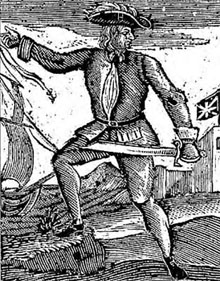
Rackham is most remembered for two things: the design of his Jolly Roger flag, a skull with crossed swords, which contributed to the popularization of the design, and for having two female crew members Mary Read and Anne Bonny.
Edward Low
1721–1724
He captained a number of ships, usually maintaining a small fleet of three or four. Low and his pirate crews captured at least a hundred ships during his short career, burning most of them. Although he was active for only three years, Low remains notorious as one of the most vicious pirates of the age, with a reputation for violently torturing his victims before killing them.
Stede Bonnet
1717–1718
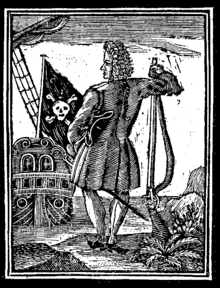
Stede Bonnet was an early 18th-century Barbadian pirate, sometimes called "The Gentleman Pirate" because he was a moderately wealthy landowner before turning to a life of crime. Bonnet was born into a wealthy English family on the island of Barbados, and inherited the family estate after his father's death in 1694. In 1709, he married Mary Allamby, and engaged in some level of militia service. Because of marital problems, and despite his lack of sailing experience, Bonnet decided to turn to piracy in the summer of 1717. He bought a sailing vessel, named it Revenge, and traveled with his paid crew along the Eastern Seaboard of what is now the United States, capturing other vessels and burning other Barbadian ships.
Bonnet set sail for Nassau, Bahamas, but he was seriously wounded en route during an encounter with a Spanish warship. After arriving in Nassau, Bonnet met Edward Teach, the infamous pirate Blackbeard. Incapable of leading his crew, Bonnet temporarily ceded his ship's command to Blackbeard. Before separating in December 1717, Blackbeard and Bonnet plundered and captured merchant ships along the East Coast. After Bonnet failed to capture the Protestant Caesar, his crew abandoned him to join Blackbeard aboard the Queen Anne's Revenge. Bonnet stayed on Blackbeard's ship as a guest, and did not command a crew again until summer 1718, when he was pardoned by North Carolina governor Charles Eden and received clearance to go privateering against Spanish shipping. Bonnet was tempted to resume his piracy, but did not want to lose his pardon, so he adopted the alias "Captain Thomas" and changed his ship's name to Royal James. He had returned to piracy by July 1718.
Walter Kennedy
1718–1721
Kennedy served in the Royal Navy during the War of Spanish Succession, where he heard tales of pirates from Henry Morgan to Henry Every, and dreamed of becoming a pirate himself. He was a crew member on the sloop-of-war Buck, part of the fleet that Woodes Rogers took to the Bahamas in 1718 to suppress piracy there. Woodes sent the Buck to Havana with a letter for the Spanish governor assuring that official that he was not a pirate, but was in Nassau to suppress piracy. Some recently pardoned pirates were added to the crew of the Buck, and before it reached Havana they, along with some of the original crew, including Kennedy, mutinied, killing the captain, Jonathan Bass, and other crew members who did not join the mutiny.
Howell Davis, another mutineer, was elected captain. Kennedy was with Davis on the island of Principe when his party was ambushed by the Portuguese. He was the only member of the shore party to escape back to the ship alive. With Davis dead, Bartholomew Roberts was elected as his successor. When Roberts and forty of the crew chased a possible prize in a captured sloop off the coast of Surinam, Kennedy was left in charge of Roberts' ship, the Royal Rover, and a large part of its crew. He took advantage of this to abandon Roberts and proclaim himself captain.
Kennedy headed for Ireland, but having no skill in navigation landed on the north-west coast of Scotland instead. Seventeen of the crew were arrested near Edinburgh and put on trial for piracy, with nine of them being hanged. Kennedy himself was able to reach London where he is said to have kept a boarding house in the Deptford Road. When one of his logers accused him of theft, he was sent to the Bridewell Prison, where he was denounced as a pirate by the mate of a ship he had taken. Kennedy was transferred to the Marshalsea prison and put on trial for piracy. He was hanged at Execution Dock on July 21, 1721.
Emanuel Wynn
Little is known of Emanuel Wynn, other than that he was a French pirate of the 18th century, and is often considered the first pirate to fly the Jolly Roger. His design incorporated an hourglass beneath the bones to represent that time was running out.
Other Known Pirates
Here are some other pirates that you might like to research further:
- Henry Morgan
- John Morris
- Thomas Paine
- Richard Sawkins
- Bartholomew Sharp
- George Booth
- John Bowen
- Black Bellamy (Samuel Bellamy)
- Anne Bonney (Anne Cormac)
- Edward England
- Benjamin Hornigold